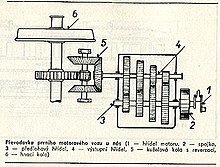ČSD series M 130.0
| ČSD series M 130.0 | |
|---|---|
| Numbering: | M 130.001 |
| Number: | 1 |
| Manufacturer: | Tatra Mountains , Kopřivnice |
| Year of construction (s): | 1927 |
| Retirement: | 1945 |
| Axis formula : | A1 |
| Gauge : | 1435 mm ( standard gauge ) |
| Length over coupling: | 9,200 mm |
| Width: | 2,500 mm |
| Total wheelbase: | 4,220 mm |
| Empty mass: | 7.3 t |
| Service mass: | 10 t |
| Friction mass: | 5 t |
| Wheel set mass : | 5 t |
| Top speed: | 65 km / h |
| Installed capacity: | 65 hp |
| Motor type: | TATRA |
| Motor type: | 6 cylinder petrol engine |
| Rated speed: | 1,800 rpm |
| Power transmission: | mechanically |
| Brake: | Knorr air brake |
| Seats: | 32 |
| Standing room: | 0 |
| Classes : | 3. |
The ČSD series M 130.0 was the forefather of all railcars manufactured by the former Czechoslovak State Railways ČSD until 1945 for local rail traffic. It was a light vehicle of a pioneering development direction for the motorization of local rail traffic at the ČSD .
history
While other companies tried to equip a bus with a railroad chassis when developing motor vehicles or to install a drive system in a railroad car, a completely new design of a rail vehicle was created at Tatra in Kopřivnice , which took over the essential elements of automobile construction, but was an independent development in the development of a light rail vehicle. Passenger traffic on many local railways owed its origin to this development.
In 1927 a motor vehicle of the M 130.0 series as a two-axle version was built near Tatra in Kopřivnice . The manufacturer's endeavor to keep the weight of the car down had remained successful. The empty weight of the car was only 7.3 t. A narrowing of the car body also helped, the width was only 2.5 m and the number of seats 32.
The motor car M 130.001 was handed over at the same time as the side car, which looked exactly the same as the motor car. With these the car formed a unit. The sidecar had no energy source for lighting and no traction brake. The electricity for the lighting was brought by a cable from the motor vehicle. There was a possibility to transport luggage, for which a special compartment was set up in the rear entry area of the sidecar. At the time the sidecars were delivered, there was still no decision on the designation of sidecars, and so the M 130.001 cars were never designated.
Although the railcar with the sidecar remained a prototype, it was in service until 1945 when it was retired.
Vehicle body
The two-axle vehicle had 2 driver's cabs at the top of the car body , which also served as entry areas. The operator's workstation was located in the middle of the entry area, as was also known from the M 120.2 . Thus, the driver's seat and entry and exit routes were not in the way. There was no space to separate the driver's cab from the entry area. Perhaps that was also the reason why the tower railcars were later developed . The control panel was simple, as was customary in automotive engineering. In the middle of the window was the throttle lever, to the left of it the clutch lever, as can still be seen today in railcars with mechanical power transmission ( ČSD series M 131.1 ). It also had elements for monitoring the vehicle and controlling ancillary systems. The shift lever, the separate lever for the reversing gear and the lever for the handbrake were designed like those of a truck. The car had no transition device and a bridge for the sidecar. It is not known whether it was retrofitted with it in the later period.
The vehicle had the automatic Knorr traction brake and simple funnel couplings as a coupling device . Around 1930 it was converted to the pulling and pushing device common to railways.
engine and gears
The water-cooled 6-cylinder Tatra petrol engine was installed under the floor. At the very high speed of 1800 revolutions per minute it made 65 hp. The cylinders had a diameter of 90 mm and a stroke of 140 mm. A mechanical change gearbox was used for power transmission , which drove an axle via a cardan shaft and bevel gears. The change of direction of travel was realized by means of a sliding bevel gear on the drive axle. The radiator was placed on the roof.
literature
- Jindřich Bek, Josef Janata, Jaroslav Veverka: Malý atlas Lokomotiv 2. Elektrická a motorová trakce. Nadas Publishing House, Prague 1969
